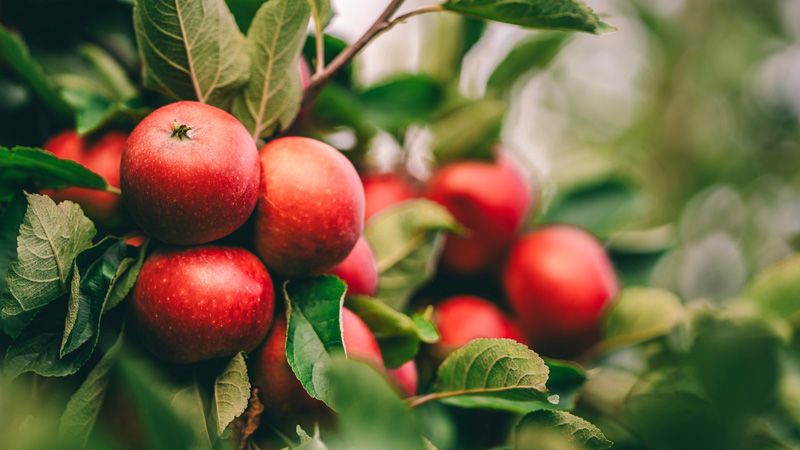Growing Apples
It is fun and everyone’s dream to grow their own apples in the Backyard. There is nothing like plucking your own organic apples, oranges, pomegranates, peaches right off your garden. However, growing fruit trees takes more than you think off- from pruning apple trees for getting your desired variety to pest and disease control.
Here are some of our expert tips to plant, grow, and harvest your own-grown apples.
Planting Apple Trees
Selection of Variety
There are more than 1000 varieties of apples grown in home gardens. When choosing your type of apples, you should consider how you want to eat your apples. Some of them are good for cooking, some for preserving, and some for fresh eating. Likewise, some varieties have different harvest seasons; some apples ripen in autumn, some in mid-summer, and some in late summer. There are few varieties of apples that need pollinators to grow. You may need to plant more than one apple tree to get fruit.
Selection of Site
- Before Planting, you need to clean out your land from any weeds and grasses.
- Protect your plant from any injury, drying roots, and freezing.
- Dig a hole approximately twice the root system’s diameter and no longer than the root ball in depth.
- Mix your soil with some organic matter and let the soil dry out—no need to add fertilizers in the soil at planting time.
- Put your plant into the hole and cover it up with soil. Fill air pockets with soil and irrigate your plant to find out more pockets and then fill them too.
Care
General care
- Water your apple trees according to a precise schedule to ensure a well-established root system.
- Refresh mulch periodically because it retains soil moisture and prevents the tree from drying out.
- Young plants need early training to nurture their branching system so that the branches can carry heavy crops.
- Pest and disease control is an essential step in plant care. Correct timing of any operation is necessary to protect the bees and, ultimately, the process of pollination. If you don’t want to use pesticides on your plants, use organic control methods to get rid of pests.
- Don’t allow weeds to grow for the first 2 to five years and replace weeds with much.
Pruning Apple Trees
Maybe you are asking yourself that why I should prune my apple tree? What is the purpose? The main reason for pruning is to have well-spaced branches and a balanced appearance. We can remove dead, thin, and injured limbs in pruning, which reduces the airflow and light. The most significant advantage of pruning is to increase fruit production and flower production. The best time to prune your apple tree is in the dormant season (mid-January).
- It would help if you had the right tools for the right job you wanted to be sharp.
- Walk up to your tree; just take a minute and take a look at it.
- Remove dead, injured, and diseased branches.
- Take back about a third from last year’s growth. This encourages the tree to produce more fruit rather than more long twiggy growth.
- The ideal space for fruiting spurs is 4 to 6 inches apart.
- Remove all the suckers.
- Prune your plant every year. Once a tree has been well pruned it will need more minor pruning in upcoming seasons.
Harvesting Apple Trees
- Harvest with patience. After all that pruning and care, be sure to harvest your apples at their peak.
- Pick your apples when their background color is no longer green.
- The stem should easily separate from the branch when the fruit is picked up with the palm of the hand and turned slightly, then upwards (do not pull the apple).
- Different varieties of apples ripen at different times, so the harvest season can be from August to October.
- If the apple is too ripe and mushy, use it for baking!
Pest, Disease and Their Management
Unfortunately, apples are susceptible to several pests and diseases.
The larvae of the apple worm burrow into the fruit, causing the infested apples to drop early. Avoid this by collecting and destroying all fallen apples every week in the summer and use apple worm traps on the tree to catch adult butterflies.
i- Apple scab
Apple scab is most common in areas with cool, wet springs. Check out olive-brown spots on the leaves and fruits.
Management
To avoid this, clean up any fallen leaves in the fall, select varieties resistant to scab, and use liquid sulfur sprays on the tree when the flower buds start to grow.
ii- Apple rust
Apple rust causes pale yellow spots on the surface of leaves and fruits. The spots grow, turn orange, and have tiny black dots.
Management
To avoid it, select varieties resistant to rust, spray a spray of liquid sulfur in the spring and remove nearby junipers.
iii- Apple moth
The apple moth is a common insect pest. Their larvae feed on the fruit by creating small holes.
Management
Avoid this by spraying with Bt, a natural bacteria, two weeks after the flower petals have fallen.
iv- Fire blight
Fire blight causes flowers to be brown and die and branches to wilt and die while the leaves are still burning.
Management
Avoid this by pruning infected shoots, cleaning up any fallen leaves in the fall, selecting varieties resistant to scab, and spraying copper and sulfur on them.
v- Powdery mildew
Powdery mildew appears to have a silvery gray coating on the leaves of plants. Often distorts new growth.
Management
To avoid this, clean off any fallen leaves in the fall, select fluffy varieties, and use liquid sulfur sprays on the tree when the flower buds start to open.

